Mathematics of leaves Unusual Japanese plant inspires recalculation of equation used to model leaf arrangement patterns Research news
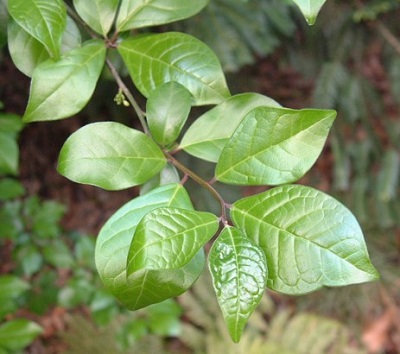
Leaves can be enjoyed for their shade, autumn colors, or taste, and the arrangement of leaves on a plant is a practical way to identify a species. However, the details of how plants control their leaf arrangement have remained a persistent mystery in botany. A Japanese plant species with a peculiar leaf pattern recently revealed unexpected insight into how almost all plants control their leaf arrangement.
“We developed the new model to explain one peculiar leaf arrangement pattern. But in fact, it more accurately reflects not only the nature of one specific plant, but the range of diversity of almost all leaf arrangement patterns observed in nature,” said Associate Professor Munetaka Sugiyama from the University of Tokyo’s Koishikawa Botanical Garden.
All in the angles
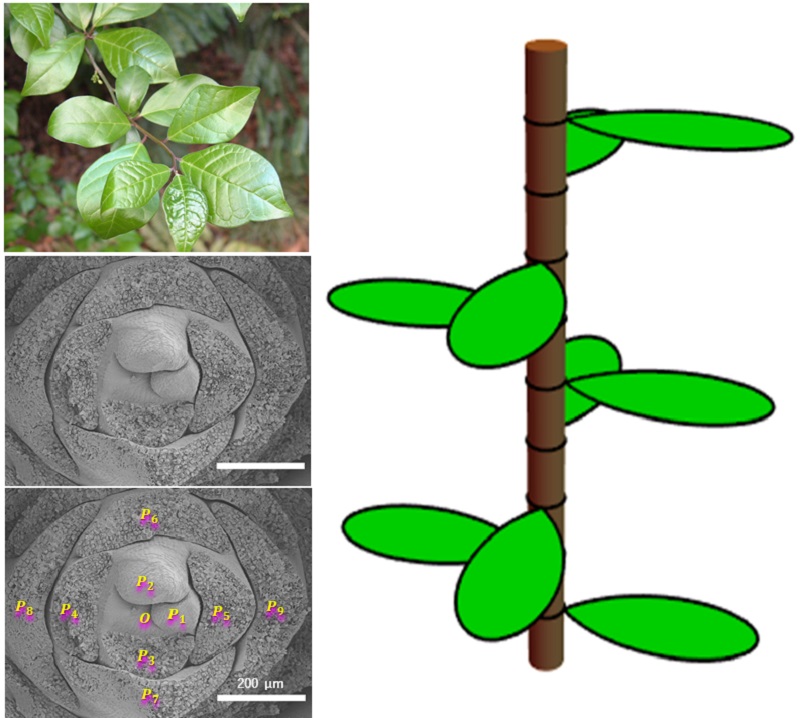
Leaves on an O. japonica branch (upper left) and a schematic diagram of orixate phyllotaxis (right). The orixate pattern displays a peculiar four-cycle change of the angle between leaves (180 degrees to 90 degrees to 180 degrees to 270 degrees). A scanning electron microscope image (center and bottom left) shows the winter bud of Orixa japonica, where leaves first begin to grow. Primordial leaves are labeled sequentially with the oldest leaf as P8 and the youngest leaf as P1. The label O marks the shoot apex.
To identify the leaf arrangement of a plant species, botanists measure the angle between leaves, moving up the stem from oldest to youngest leaf.
Common patterns are symmetrical and have leaves arranged at regular intervals of 90 degrees (basil or mint), 180 degrees (stem grasses, like bamboo), or in Fibonacci golden angle spirals (like the needles on some spherical cacti, or the succulent spiral aloe).
The peculiar pattern that Sugiyama’s research team studied is called “orixate” after the species Orixa japonica, a shrub native to Japan, China, and the Korean peninsula. O. japonica is sometimes used as a hedge.
The angles between O. Japonica leaves are 180 degrees, 90 degrees, 180 degrees, 270 degrees, and then the next leaf resets the pattern to 180 degrees.
"Our research has the potential to truly understand beautiful patterns in nature," said Sugiyama.
The math of a plant
Sugiyama’s research team began their investigation by doing exhaustive testing of the existing mathematical equation used to model leaf arrangement.
Leaf arrangement has been modeled mathematically since 1996 using an equation known as the DC2 (Douady and Couder 2). The equation can generate many, but not all, leaf arrangement patterns observed in nature by changing the value of different variables of plant physiology, such as the relationships between different plant organs or strength of chemical signals within the plant.
The DC2 has two shortcomings that researchers wanted to address:
1) No matter what values are put into the DC2 equation, certain uncommon leaf arrangement patterns are never calculated.
2) The Fibonacci spiral leaf arrangement pattern is by far the most common spiral pattern observed in nature, but is only modestly more common than other spiral patterns calculated by the DC2 equation.
A peculiar pattern

Expanded Douady and Couder 2 simulation of orixate phyllotaxis. Video by Takaaki Yonekura, CC-BY-ND, originally published in PLOS Computational Biology DOI: 10.1371/journal.pcbi.1007044
At least four unrelated plant species possess the unusual orixate leaf arrangement pattern. Researchers suspected that it must be possible to create the orixate pattern using the fundamental genetic and cellular machinery shared by all plants because the alternative possibility — that the same, very unusual leaf arrangement pattern evolved four or more separate times — seemed too unlikely.
One fundamental assumption used in the DC2 equation is that leaves emit a constant signal to inhibit the growth of other leaves nearby and that the signal gets weaker at longer distances. Researchers suspect that the signal is likely related to the plant hormone auxin, but the exact physiology remains unknown.
Rare patterns and common rules
“We changed this one fundamental assumption — inhibitory power is not constant, but in fact changes with age. We tested both increasing and decreasing inhibitory power with greater age and saw that the peculiar orixate pattern was calculated when older leaves had a stronger inhibitory effect,” said Sugiyama.
This insight into the inhibitory signal power changing with age may be used to direct future studies of the genetics or physiology of plant development.
Researchers call this new version of the equation the EDC2 (Expanded Douady and Couder 2).
First author of the research paper, doctoral student Takaaki Yonekura, designed computer simulations to generate thousands of leaf arrangement patterns calculated by EDC2 and to count how often the same patterns were generated. Patterns that are more commonly observed in nature were more frequently calculated by the EDC2, further supporting the accuracy of the ideas used to create the formula.
“There are other very unusual leaf arrangement patterns that are still not explained by our new formula. We are now trying to design a new concept that can explain all known patterns of leaf arrangement, not just almost all patterns,” said Sugiyama.
Each video below shows a top-down view of leaf arrangement patterns as new leaves (red semicircles) form from the shoot apex (central black circle) and grow outwards. The inhibitory field is represented as a contour map, where red represents strongest inhibitory strength and blue represents weakest inhibitory strength.
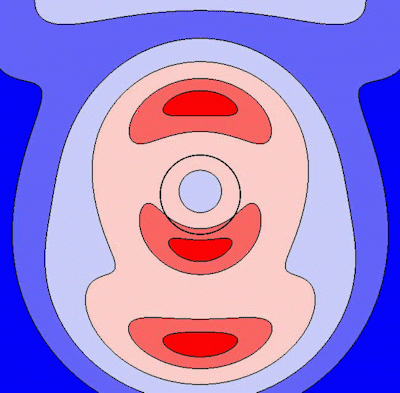
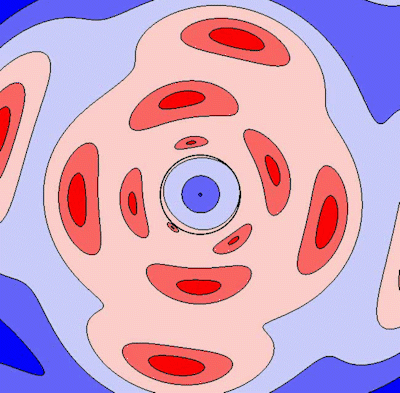

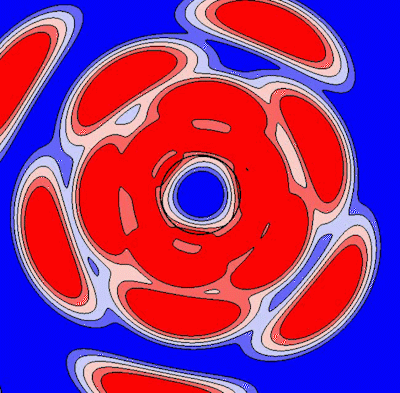
Do it yourself — ID the pattern
Experts recommend looking at a group of relatively new leaves when identifying a plant’s leaf arrangement, or phyllotaxis, pattern. (In Greek, phyllon means leaf.) Older leaves may have turned (due to wind or sun exposure), which can make it difficult to identify their true angle of attachment to the stem.
Think of the stem as a circle and begin by carefully observing where on the circle the oldest and second-oldest leaves are attached. The angle between those two leaves is the first “angle of divergence.” Continue identifying the angles of divergence between increasingly younger leaves on the stem. The pattern of angles of divergence is the leaf arrangement pattern.
Common leaf arrangement patterns are distichous (regular 180 degrees, bamboo), Fibonacci spiral (regular 137.5 degrees, the succulent Graptopetalum paraguayense), decussate (regular 90 degrees, the herb basil), and tricussate (regular 60 degrees, Nerium oleander sometimes known as dogbane).
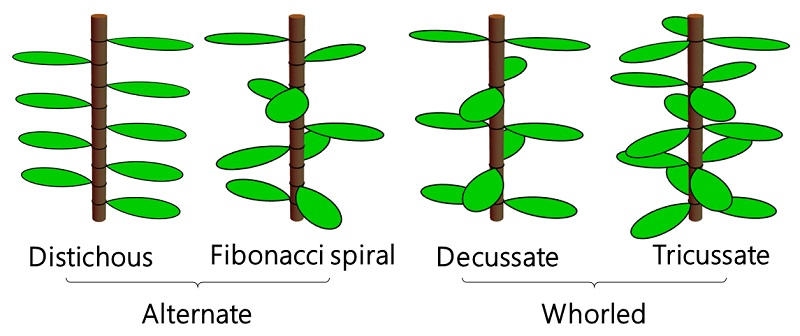
Leaf arrangement with one leaf per node is called alternate phyllotaxis whereas arrangement with two or more leaves per node is called whorled phyllotaxis. Common alternate types are distichous phyllotaxis (bamboo) and Fibonacci spiral phyllotaxis (the succulent spiral aloe), and common whorled types are decussate phyllotaxis (basil or mint) and tricussate phyllotaxis (Nerium oleander, sometimes known as dogbane). Image by Takaaki Yonekura, CC-BY-ND
Papers
Takaaki Yonekura, Akitoshi Iwamoto, Hironori Fujita, Munetaka Sugiyama, "Mathematical model studies of the comprehensive generation of major and minor phyllotactic patterns in plants with a predominant focus on orixate phyllotaxis," PLOS Computational Biology: June 6, 2019, doi:10.1371/journal.pcbi.1007044 .
Link (Publication , UTokyo Repository
, UTokyo Repository )
)





